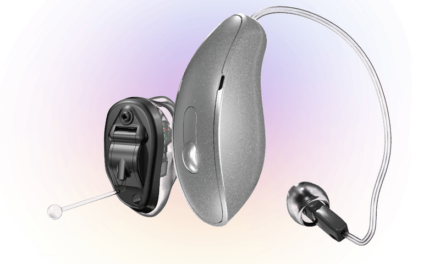Modern digital hearing instruments are often characterized by sophisticated algorithms and speech processing strategies, noise canceling systems, as well as fully automated program selection systems and multi-microphone technologies. The objective of combining such diverse technologies is to improve speech comprehension, especially in noise and in frequently changing listening situations.
Such hearing systems have been developed primarily for adults. However, since hearing aids for children must meet requirements which differ considerably from those for adults, the question arises whether the new hearing aid technologies are also applicable for children.
The following clinical trial attempts to answer this question by studying 20 children with hearing loss who were fitted with a digital test hearing instrument (Phonak Claro 211/311 BTE) that utilizes a directional system. The fitting took place under clinical conditions and within the framework of a comparative fitting scheme. Specifically, the clinical trial was designed to answer the following questions:
- Are the test hearing instruments suitable for the amplification of children?
- How useful is the default setting recommended by the manufacturer’s fitting software on the basis of the DSL[i/o]2 method?
- Can children make effective use of the various programs provided?
- Is it possible to achieve better speech comprehension in noise?
- Are the test hearing systems suitable even for borderline cases (eg, children with profound hearing loss, with learning impairment, or physical handicaps)?
Study Methods
Test instruments: The underlying psycho-acoustic model1 for the Claro hearing system, which operates in 20 overlapping frequency bands, takes account of the frequency-independent masking pattern which characterizes individual auditory perception. Adaptively controlled directional microphones and a Fine-Scale Noise Canceler (FNC) are designed to facilitate speech comprehension in noise.
Various hearing programs can be selected. The first program is designed for quiet listening situations; the second program (with FNC and directionality) is designed for a high level of speech comprehension in noise. Switching is accomplished via a program selection switch on the instrument, by remote control (not used in this study), or by an automatic program selection system which activates the appropriate program after analyzing the prevailing listening situation.
Subjects: A total of 20 children and adolescents ages 10 years to 17 years (average = 12.11 years) participated in the trial. The basic inclusion criterion was sufficient verbal competence to allow speech recognition testing. In addition, the subjects had to be capable of giving a differentiated assessment of the hearing instruments. Only children and adolescents who attended mainstream schools were included.
Of the 20 children and adolescents, 3 had mild or mild-to-moderate hearing loss, 10 had moderate or moderate-to-severe hearing loss, and 7 had severe or profound hearing loss (Figure 1). Sixteen children had previously worn hearing instruments and 4 were first-time fittings. All children were fitted binaurally.
Figure 1. Averaged audiograms of the children and adolescents. Red line represents subjects who subsequently received Claro 211 dAZ; blue line represents to subjects who subsequently received Claro 311 dAZ
Hearing instrument fitting: At our clinic, initial and follow-up fitting is carried out according to a comparative fitting scheme and under in-patient conditions. Children from the age of 6 years old usually stay at the clinic for about 2 weeks. During this period, the children are supervised by trained educators, rehabilitation therapists, and pediatric nurses who are in permanent contact with the therapists (audiology assistants). This makes it possible to observe the children in more situations than the fitting (ie, during outdoor activities, sports, etc).
After the medical and logopedic work-up, the following initial examinations are carried out to obtain the prerequisite data before fitting the hearing instruments:
- Pure-tone audiometry;
- Tympanometry/stapedius reflex measurement;
- Threshold evoked otoacoustic emissions (OAEs)/distortion product otoacoustic emissions (DPOAEs);
- Auditory Brainstem Response (ABR) (if necessary);
- Determination of the Uncomfortable Loudness Level (UCL), if measurable;
- Speech audiometry (Göttinger II, Freiburger), monaural, free-field, with and without hearing aid, with and without noise (50 dB noise level from behind/65 dB speech level from front). The selection of the speech test depends on the subject’s age.
These data serve as a basis for clinical fitting. Usually, at least one analog, one analog programmable, and one digital instrument are selected for comparative fitting.
Adjustments and trial standards: In this study, each child was fitted with an average of four pairs of hearing aids by other manufacturers plus one pair of the test hearing systems. The initial setting of the instruments was obtained with the DSL fitting procedure2 with individually measured real-ear-to-coupler difference (RECD), which is routine fitting procedure for children at our clinic. The precalculation according to DSL was selected in the fitting software of the test instruments, and the initial setting was verified by in-situ measurements with the Maico Scan MH 20.
Using the initial setting, two free-field speech tests (Göttinger II or Freiburger Monosyllable) were carried out. The word sets of the tests without noise were tested with Program P1, whereas those with noise were tested with Program P2. The noise used was a broadband signal.
The initial setting of the instruments was modified if the speech test result was inadequate or, in the case of follow-up fittings, if it was inferior or only equal to the result obtained with the previously worn hearing instruments. In addition, changes were also made if the hearing instruments were judged unsatisfactory by the child or the supervisor.
After each adjustment of the initial setting, the new setting was retested with the two speech tests (as described above). The children were instructed in great detail on the operation of the program selection switch on the test hearing instrument. Those parents who visited their children during their stay at the clinic were also educated extensively about the instruments and their operation.
Children who opted (among others) for a test instrument pair during the comparative fitting at the clinic received these instruments (plus an additional pair which was assessed as “good”) on a lend-out basis to try them out at home and at school. During the final examination, parents and children were asked to make the ultimate choice of instrument.
Results
Acceptance of initial fitting and adjustments. The initial setting obtained with the PFG fitting software (precalculation according to DSL, selected amplification level “Experienced User,” and WDRC) was immediately accepted by all children and adolescents, including all first-time users. The amplification level “Long-term user” proved to be “too loud” in the 1 kHz range for 8 children. This “too loud” assessment was defined by the investigators as 5-10 dB above the real-ear aided response (REAR) or 5-10 dB above the real-ear saturation response (RESR).
Figure 1. Average fine-tuning effort for Claro 211 (top) and Claro 311 (bottom). The thin bars indicate the maximum changes for each parameter.
In 13 out of 40 test instruments, the initial setting needed no fine-tuning because it was subjectively assessed as good by the children (19 binaurally fitted with symmetrical hearing loss, and 1 binaurally fitted with asymmetrical hearing loss). This result coincided with the results of the in-situ measurements (ie, agreement with the DSL target) and the speech tests. Twenty-seven initial instrument settings were fine-tuned (Figure 2). On average, the gain in the high frequencies was slightly increased, especially for low input levels (eg, less than 50 dB). In the Claro 311 dAZ, this was generally accompanied by an increase of low frequency gain.
Speech comprehension. The speech tests in quiet were carried out at 50 dB, 60 dB, and 80 dB stimulus level. Speech comprehension in noise was tested at 65 dB with simultaneous presentation of a 50 dB broadband noise from behind. For the speech tests in quiet, the children used Program P1. For the tests in noise, they used Program P2. In this program, the FNC was set to “light” and the directional microphone was activated.
In only 3 of 14 children whose settings had been fine-tuned, the adjustment did not result in better speech understanding, although subjective acceptance was improved. In the other 11 children, speech understanding was improved, especially at low input levels (Table 1). This improvement was primarily due to an increase in high-frequency gain for low input levels (Figure 2). In the speech tests in noise, children achieved an average speech comprehension score of 88% with the test hearing instruments. Sixteen of 20 children performed above 80%. Only 4 children performed at 70%. Of these, 2 had profound hearing loss, one was learning-disabled, and one had previously been clearly over-amplified.

Average speech comprehension scores with the test hearing instruments after fine-tuning, compared to the children’s own hearing aids, are shown in Table 2. Speech recognition was improved, especially at low input levels and in noise.
Take-Home Trials and Results
At the end of the clinical trial period, the speech tests and the subjective assessment of the test instruments were so positive that these aids were lent to 18 children for further testing at home. Two of 20 children were apparently so accustomed to their previous hearing aids that they declined further testing at home in spite of good results in the speech tests.
On average, four additional pairs of analog and digital hearing aids by various manufacturers were also fitted and tested on each child during the clinical period. In each case, the pair that received the best rating was also lent to the child for home testing—in addition to the test hearing instrument pair.
Results after home testing. Of the 18 children who tested the experimental hearing instruments at home during 6 to 8 weeks, 12 ultimately opted for these instruments. Among the 6 children who opted for other instruments, various aspects determined the choice. Either speech comprehension or sound was perceived to be better with other digital instruments, or the child was deeply accustomed to the tone of the (analog) pair he/she had previously worn for years.
Use of different hearing programs. A questionnaire was used to assess the everyday use of the different programs of the test hearing instruments. After 3 months of use, the parents of the 12 children with the test hearing instruments received the questionnaire. Eleven questionnaires were returned. The results indicate that, after 3 months of use, 10 of 11 children had used all the programs on a regular basis. These children welcomed the choice of different listening programs. The great variance of program usage patterns among the children indicates that the selection of programs is a highly individualized choice which precludes any general recommendation.
In our view, the option of automatic program selection in addition to manual selection is an advantage because it enables adequate support in many situations for those children who do not make optimal use of the manual option. One child perceived the option of several programs as annoying. For this child, getting accustomed to the sound of a new hearing instrument appeared to be a challenge in itself, which we took into account by deactivating Program P2 (NoiseAdapt). The intention is to offer Program P2 to this child at a later stage.
Discussion
Our investigations indicate that the digital directional hearing instruments (Claro 211/311 dAZ) in this study can be used in the amplification of children and adolescents, provided the children have already achieved sufficient verbal competence to perform speech tests. These results, in part, are supported by research conducted by Condie et al.3 who found that the same digital directional test instruments were preferred by children ages 5-14. In contrast to adults, children cannot usually provide the differential information required for initial fitting. It is therefore recommended to perform the initial fitting according to the DSL[i/o] procedure using the manufacturer’s fitting software.
When hearing aids are fitted on adult patients, it is consistently observed that the target curve can only be approached slowly and in a number of small steps. Adult patients first need to get accustomed to many new sounds and noises which have become unfamiliar.
Children react differently. They demand loudness, and they enjoy every new sound they can hear. Moreover, they are in a learning stage and need to move as quickly as possible from the “fitting” to the “fine-tuning” stage. Therefore, as counter-intuitive as it may sound, the “Experienced User” setting has proved to be reliable for the initial fitting. The “Long-term User” setting can sometimes be too loud and should, in our view, not be the standard for the initial fitting in children. Although the “Experienced User” setting for initial fitting immediately yielded good results, it was shown that improvements could still be obtained in the speech test and in the subjective assessment if adjustments or fine-tuning of the initial settings were carried out.
As early as during the clinical fitting period, it became obvious that the children who participated in the study were intuitively able to operate the TacTronic switch. All children began to make use of the different programs. A questionnaire submitted to the test instrument wearers after 3 months indicated that nearly all patients regularly used 2 or more programs. However, which program they used, and how often, greatly depended on the individual child. As a result, no general recommendation can be made.
After the first positive results, we decided to include “borderline cases” into the study (ie, 3 children with profound hearing loss, 2 children with learning disabilities, and 1 child with a physical disability). These cases indicated that the digital directional hearing instruments provide sufficient gain even for the most severe hearing losses. The successful treatment of the children with physical and learning disabilities was greatly assisted by their highly cooperative parents and the correspondingly high level of support these patients received. Treatment of such borderline cases with this type of instrument can therefore not be generally recommended, but should be taken into consideration if similarly favorable circumstances exist.
On the basis of our experience and of the present study, we conclude that these digital directional hearing instruments can be successfully used in the treatment of children and result in improved speech comprehension, good sound quality, and high acceptance. It is essential, however, that both the children and their parents are cooperative and motivated.
We did not investigate the use of the test hearing instruments in pre-school children. It can therefore not be reliably assessed whether the use of noise canceling systems or automatic directional microphones in infants and toddlers can improve speech and language development and do not affect central processing mechanisms.
Moreover, the use of multi-program functions is highly age-dependent. It is possible that younger children might, for example, select Program 2 in a noisy environment but forget to switch back when in quiet.
Therefore, based on our long experience in the treatment of children, we would caution against the general use of such features for pre-school children. However, the instruments make it possible to activate only one program at first, and to widen the choice gradually as the child gets older and learns to adapt to different listening situations.
| This article was submitted to HR by Andrea Bohnert, MTA, and Petra Brantzen, MTA, who are audiologists affiliated with the Clinic for Communication Disorders at Johannes Gutenberg University in Mainz, Germany. Correspondence can be addressed to HR or to: Andrea Bohnert, MTA, Mainz Univ. Hospital, Clinic for Communication Disorders, Langenbeckstrasse 1, Building 102, 55101 Mainz, Germany; email: [email protected]. |
References
1. Launer S. Loudness perception in listeners with sensorineural hearing impairment [PhD dissertation]. Universität Oldenburg, Available at: http://www.physik.unioldenburg.de/Docs/medi/pub_down.html;1995.
2. Cornelisse LE, Seewald RC, Jamieson DG. The input/output (i/o) formulae: A theoretical approach to the fitting of personal amplification devices. J Acoust Soc Am. 1995;97(3):1854-64
3. Condie RK, Scollie SD, Checkley P. Children’s performance: Analog vs digital adaptive dual-microphone instruments. Hearing Review. 2002;9(6):40-43,56.

.gif)
.gif)
.gif)
.gif)



